Advancing Nature-Based Solutions with Artificial Intelligence: A Bibliometric and Semantic Analysis Using ChatGPT
Abstract
1. Introduction
2. Materials and Methods
2.1. Data Collection
2.2. Data Processing
- (1)
- Bibliometric Network Construction
- (2)
- Topic Clustering and Keyword Extraction
- (3)
- LLM-based Semantic Enhancement for Topic Labeling
“You are an academic expert in environmental science and artificial intelligence. Based on the following list of high-frequency keywords extracted from a bibliometric clustering analysis, please generate (i) a concise research topic label (≤10 words) and (ii) a one-sentence thematic summary highlighting the research scope and focus. Keywords: {keyword_list}.”
- (4)
- Expert Validation
3. Results and Discussion
3.1. Research Development Trends in AI-NBS
3.1.1. Publication Growth Patterns
3.1.2. Keyword Co-Occurrence Network Analysis
3.2. Thematic Structure and Application Domains
3.3. Temporal Citation Dynamics and Emerging Hot Spots
4. Conclusions
Author Contributions
Funding
Institutional Review Board Statement
Informed Consent Statement
Data Availability Statement
Acknowledgments
Conflicts of Interest
References
- Eckart, K.; McPhee, Z.; Bolisetti, T. Performance and Implementation of Low Impact Development—A Review. Sci. Total Environ. 2017, 607–608, 413–432. [Google Scholar] [CrossRef]
- Wang, M.; Zhang, D.; Wang, Z.; Zhou, S.; Tan, S.K. Long-Term Performance of Bioretention Systems in Storm Runoff Management under Climate Change and Life-Cycle Condition. Sustain. Cities Soc. 2021, 65, 102598. [Google Scholar] [CrossRef]
- Wang, M.; Zhang, Y.; Bakhshipour, A.E.; Liu, M.; Rao, Q.; Lu, Z. Designing Coupled LID–GREI Urban Drainage Systems: Resilience Assessment and Decision-Making Framework. Sci. Total Environ. 2022, 834, 155267. [Google Scholar] [CrossRef]
- Raymond, C.M.; Frantzeskaki, N.; Kabisch, N.; Berry, P.; Breil, M.; Nita, M.R.; Geneletti, D.; Calfapietra, C. A Framework for Assessing and Implementing the Co-Benefits of Nature-Based Solutions in Urban Areas. Environ. Sci. Policy 2017, 77, 15–24. [Google Scholar] [CrossRef]
- Key, I.B.; Smith, A.C.; Turner, B.; Chausson, A.; Girardin, C.A.J.; Macgillivray, M.; Seddon, N. Biodiversity Outcomes of Nature-Based Solutions for Climate Change Adaptation: Characterising the Evidence Base. Front. Environ. Sci. 2022, 10, 905767. [Google Scholar] [CrossRef]
- Wang, M.; Sun, C.; Zhang, D. Opportunities and Challenges in Green Stormwater Infrastructure (GSI): A Comprehensive and Bibliometric Review of Ecosystem Services from 2000 to 2021. Environ. Res. 2023, 236, 116701. [Google Scholar] [CrossRef]
- Sun, C.; Rao, Q.; Chen, B.; Liu, X.; Adnan Ikram, R.M.; Li, J.; Wang, M.; Zhang, D. Mechanisms and Applications of Nature-Based Solutions for Stormwater Control in the Context of Climate Change: A Review. Atmosphere 2024, 15, 403. [Google Scholar] [CrossRef]
- He, X.; Wei, H.; Li, S. Research Progress and Application Prospect of Nature-Based Solutions in China. Front. Environ. Sci. 2023, 11, 1133433. [Google Scholar] [CrossRef]
- Francini, S.; Schelhaas, M.-J.; Vangi, E.; Lerink, B.; Nabuurs, G.-J.; McRoberts, R.E.; Chirici, G. Forest Species Mapping and Area Proportion Estimation Combining Sentinel-2 Harmonic Predictors and National Forest Inventory Data. Int. J. Appl. Earth Obs. Geoinf. 2024, 131, 103935. [Google Scholar] [CrossRef]
- Sowińska-Świerkosz, B.; García, J.; Wendling, L. Linkages between the Concept of Nature-Based Solutions and the Notion of Landscape. Ambio 2024, 53, 227–241. [Google Scholar] [CrossRef]
- Frantzeskaki, N.; Vandergert, P.; Connop, S.; Schipper, K.; Zwierzchowska, I.; Collier, M.; Lodder, M. Examining the Policy Needs for Implementing Nature-Based Solutions in Cities: Findings from City-Wide Transdisciplinary Experiences in Glasgow (UK), Genk (Belgium) and Poznan (Poland). Land Use Policy 2020, 96, 104688. [Google Scholar] [CrossRef]
- Rolnick, D.; Donti, P.L.; Kaack, L.H.; Kochanski, K.; Lacoste, A.; Sankaran, K.; Ross, A.S.; Milojevic-Dupont, N.; Jaques, N.; Waldman-Brown, A.; et al. Tackling Climate Change with Machine Learning. ACM Comput. Surv. 2022, 55, 1–96. [Google Scholar] [CrossRef]
- Reichstein, M.; Camps-Valls, G.; Stevens, B.; Jung, M.; Denzler, J.; Carvalhais, N. Prabhat Deep Learning and Process Understanding for Data-Driven Earth System Science. Nature 2019, 566, 195–204. [Google Scholar] [CrossRef]
- Olden, J.D.; Lawler, J.J.; Poff, N.L. Machine Learning Methods without Tears: A Primer for Ecologists. Q. Rev. Biol. 2008, 83, 171–193. [Google Scholar] [CrossRef]
- Chen, X.; Wei, Q.; Li, X. Research on Multiobjective Optimization Strategy of Economic/Environmental Energy Management for Multi-Energy Ship Based on MOEA/D. In Proceedings of the Bio-Inspired Computing: Theories and Applications, Qingdao, China, 23–25 October 2020; Pan, L., Liang, J., Qu, B., Eds.; Springer: Singapore, 2020; pp. 135–146. [Google Scholar]
- Xu, P.; Zhu, X.; Clifton, D.A. Multimodal Learning with Transformers: A Survey. IEEE Trans. Pattern Anal. Mach. Intell. 2023, 45, 12113–12132. [Google Scholar] [CrossRef]
- Alaba, S.Y.; Prior, J.H.; Shah, C.; Nabi, M.M.; Ball, J.E.; Moorhead, R.; Campbell, M.D.; Wallace, F.; Grossi, M.D. Multi-Fish Tracking for Marine Biodiversity Monitoring. In Proceedings of the Ocean Sensing and Monitoring XVI, National Harbor, MA, USA, 21–25 April 2024; Hou, W., Mullen, L.J., Eds.; Spie-Int Soc Optical Engineering: Bellingham, DC, USA, 2024; Volume 13061, p. 130610E. [Google Scholar]
- Wang, M.; Fu, X.; Zhang, D.; Chen, F.; Liu, M.; Zhou, S.; Su, J.; Tan, S.K. Assessing Urban Flooding Risk in Response to Climate Change and Urbanization Based on Shared Socio-Economic Pathways. Sci. Total Environ. 2023, 880, 163470. [Google Scholar] [CrossRef]
- Wang, M.; Li, Y.; Yuan, H.; Zhou, S.; Wang, Y.; Ikram, R.M.A.; Li, J. An XGBoost-SHAP Approach to Quantifying Morphological Impact on Urban Flooding Susceptibility. Ecol. Indic. 2023, 156, 111137. [Google Scholar] [CrossRef]
- Mora-Cross, M.; Calderon-Ramirez, S. Uncertainty Estimation in Large Language Models to Support Biodiversity Conservation. In Proceedings of the 2024 Conference of the North American Chapter of the Association for Computational Linguistics: Human Language Technologies (Volume 6: Industry Track), Mexico City, Mexico, 16–21 June 2024; Yang, Y., Davani, A., Sil, A., Kumar, A., Eds.; Association for Computational Linguistics: Mexico City, Mexico, 2024; pp. 368–378. [Google Scholar]
- Wilkinson, M.D.; Dumontier, M.; Aalbersberg, I.J.; Appleton, G.; Axton, M.; Baak, A.; Blomberg, N.; Boiten, J.-W.; Santos, L.B.D.S.; Bourne, P.E.; et al. Addendum: The FAIR Guiding Principles for scientific data management and stewardship. Sci. Data 2019, 6, 6. [Google Scholar] [CrossRef] [PubMed]
- Wesselkamp, M.; Moser, N.; Kalweit, M.; Boedecker, J.; Dormann, C.F. Process-Informed Neural Networks: A Hybrid Modelling Approach to Improve Predictive Performance and Inference of Neural Networks in Ecology and Beyond. Ecol. Lett. 2024, 27, e70012. [Google Scholar] [CrossRef] [PubMed]
- Strubell, E.; Ganesh, A.; McCallum, A. Energy and Policy Considerations for Modern Deep Learning Research. In Proceedings of the Thirty-Fourth Aaai Conference on Artificial Intelligence, the Thirty-Second Innovative Applications of Artificial Intelligence Conference and the Tenth Aaai Symposium on Educational Advances in Artificial Intelligence, New York, NY, USA, 7–12 February 2020; Assoc Advancement Artificial Intelligence: Palo Alto, CA, USA, 2020; Volume 34, pp. 13693–13696. [Google Scholar]
- Donthu, N.; Kumar, S.; Mukherjee, D.; Pandey, N.; Lim, W.M. How to Conduct a Bibliometric Analysis: An Overview and Guidelines. J. Bus. Res. 2021, 133, 285–296. [Google Scholar] [CrossRef]
- Chen, C. Science Mapping: A Systematic Review of the Literature. J. Data Inf. Sci. 2017, 2, 1–40. [Google Scholar] [CrossRef]
- Van Dis, E.A.M.; Bollen, J.; Zuidema, W.; Van Rooij, R.; Bockting, C.L. ChatGPT: Five Priorities for Research. Nature 2023, 614, 224–226. [Google Scholar] [CrossRef]
- Callon, M.; Courtial, J.-P.; Turner, W.A.; Bauin, S. From Translations to Problematic Networks: An Introduction to Co-Word Analysis. Soc. Sci. Inf. 1983, 22, 191–235. [Google Scholar] [CrossRef]
- Leydesdorff, L.; Rafols, I. Indicators of the Interdisciplinarity of Journals: Diversity, Centrality, and Citations. J. Informetr. 2011, 5, 87–100. [Google Scholar] [CrossRef]
- Chen, C. CiteSpace II: Detecting and Visualizing Emerging Trends and Transient Patterns in Scientific Literature. J. Am. Soc. Inf. Sci. Technol. 2006, 57, 359–377. [Google Scholar] [CrossRef]
- Beltagy, I.; Lo, K.; Cohan, A. SCIBERT: A Pretrained Language Model for Scientific Text. In Proceedings of the 2019 Conference on Empirical Methods in Natural Language Processing and the 9th International Joint Conference on Natural Language Processing (EMNLP-IJCNLP 2019): Proceedings of the Conference, Hong Kong, China, 3–7 November 2019; Assoc Computational Linguistics-Acl: New York, NY, USA, 2019; pp. 3615–3620. [Google Scholar]
- Groos, O.V.; Pritchard, A. Documentation Notes. J. Doc. 1969, 25, 344–349. [Google Scholar] [CrossRef]
- Bohan, D.A.; Caron-Lormier, G.; Muggleton, S.; Raybould, A.; Tamaddoni-Nezhad, A. Automated Discovery of Food Webs from Ecological Data Using Logic-Based Machine Learning. PLoS ONE 2011, 6, e29028. [Google Scholar] [CrossRef] [PubMed]
- Speizer, S.; Raymond, C.; Ivanovich, C.; Horton, R.M. Concentrated and Intensifying Humid Heat Extremes in the IPCC AR6 Regions. Geophys. Res. Lett. 2022, 49, e2021GL097261. [Google Scholar] [CrossRef]
- Vaswani, A.; Shazeer, N.; Parmar, N.; Uszkoreit, J.; Jones, L.; Gomez, A.N.; Kaiser, L.; Polosukhin, I. Attention Is All You Need. In Proceedings of the Advances in Neural Information Processing Systems 30 (NIPS 2017), Long Beach, CA, USA, 4–9 December 2017; Guyon, I., Luxburg, U.V., Bengio, S., Wallach, H., Fergus, R., Vishwanathan, S., Garnett, R., Eds.; Neural Information Processing Systems (NIPS): San Diego, CA, USA, 2017; Volume 30. [Google Scholar]
- Ma, Y.; Chen, S.; Ermon, S.; Lobell, D.B. Transfer Learning in Environmental Remote Sensing. Remote Sens. Environ. 2024, 301, 113924. [Google Scholar] [CrossRef]
- Robuchon, M.; da Silva, J.; Dubois, G.; Gumbs, R.; Hoban, S.; Laikre, L.; Owen, N.R.; Perino, A. Conserving Species’ Evolutionary Potential and History: Opportunities under the Kunming-Montreal Global Biodiversity Framework. Conserv. Sci. Pract. 2023, 5, e12929. [Google Scholar] [CrossRef]
- Hong, D.; Li, C.; Zhang, B.; Yokoya, N.; Benediktsson, J.A.; Chanussot, J. Multimodal Artificial Intelligence Foundation Models: Unleashing the Power of Remote Sensing Big Data in Earth Observation. Innovation 2024, 2, 100055. [Google Scholar] [CrossRef]
- Wu, R.; Liang, Y.; Lin, L.; Zhang, Z. Spatiotemporal Multivariate Weather Prediction Network Based on CNN-Transformer. Sensors 2024, 24, 7837. [Google Scholar] [CrossRef] [PubMed]
- Jia, J.; Cui, W.; Liu, J. Urban Catchment-Scale Blue-Green-Gray Infrastructure Classification with Unmanned Aerial Vehicle Images and Machine Learning Algorithms. Front. Environ. Sci. 2022, 9, 778598. [Google Scholar] [CrossRef]
- Bolon-Canedo, V.; Moran-Fernandez, L.; Cancela, B.; Alonso-Betanzos, A. A Review of Green Artificial Intelligence: Towards a More Sustainable Future. Neurocomputing 2024, 599, 128096. [Google Scholar] [CrossRef]
- Ezenkwu, C.P.; Cannon, S.; Ibeke, E. Monitoring Carbon Emissions Using Deep Learning and Statistical Process Control: A Strategy for Impact Assessment of Governments’ Carbon Reduction Policies. Environ. Monit. Assess. 2024, 196, 231. [Google Scholar] [CrossRef]
- Bhamjee, M.; Debary, H.; Gaffoor, Z.; Govindasamy, T.; Mahlasi, C.; Fiaz, M.; Vos, E.; Klein, L.; Makhanya, S.; Watson, C.; et al. Detection and Characterization of Urban Heat Islands with Machine Learning. In Proceedings of the IGARSS 2024-2024 IEEE International Geoscience and Remote Sensing Symposium, IGARSS 2024, Athens, Greece, 7–12 July 2024; IEEE: New York, NY, USA, 2024; pp. 1693–1699. [Google Scholar]
- Liao, J.; Kim, H.Y. The Relationship between Green Infrastructure and Air Pollution, History, Development, and Evolution: A Bibliometric Review. Sustainability 2024, 16, 6765. [Google Scholar] [CrossRef]
- Zhang, Q. Application of Remote Sensing Image Processing Based on Artificial Intelligence in Landscape Pattern Analysis. Environ. Earth Sci. 2024, 83, 654. [Google Scholar] [CrossRef]
- Ji, L.; Huang, X. Analysis of Social Governance in Energy-Oriented Cities Based on Artificial Intelligence. Energy Rep. 2022, 8, 11151–11160. [Google Scholar] [CrossRef]
- Yin, X.; Li, J.; Kadry, S.N.; Sanz-Prieto, I. Artificial Intelligence Assisted Intelligent Planning Framework for Environmental Restoration of Terrestrial Ecosystems. Environ. Impact Assess. Rev. 2021, 86, 106493. [Google Scholar] [CrossRef]
- Deleglise, H.; Justeau-Allaire, D.; Mulligan, M.; Espinoza, J.-C.; Isasi-Catala, E.; Alvarez, C.; Condom, T.; Palomo, I. Integrating Multi-Objective Optimization and Ecological Connectivity to Strengthen Peru’s Protected Area System towards the 30*2030 Target. Biol. Conserv. 2024, 299, 110799. [Google Scholar] [CrossRef]
- Pham, T.D.; Ha, N.T.; Saintilan, N.; Skidmore, A.; Phan, D.C.; Le, N.N.; Viet, H.L.; Takeuchi, W.; Friess, D.A. Advances in Earth Observation and Machine Learning for Quantifying Blue Carbon. Earth-Sci. Rev. 2023, 243, 104501. [Google Scholar] [CrossRef]
- Eslamirad, N.; Kolbadinejad, S.M.; Mahdavinejad, M.; Mehranrad, M. Thermal Comfort Prediction by Applying Supervised Machine Learning in Green Sidewalks of Tehran. Smart Sustain. Built Environ. 2020, 9, 361–374. [Google Scholar] [CrossRef]
- Chen, Y.; Jin, S. Artificial Intelligence and Carbon Emissions in Manufacturing Firms: The Moderating Role of Green Innovation. Processes 2023, 11, 2705. [Google Scholar] [CrossRef]
- Chen, S.H.; Jakeman, A.J.; Norton, J.P. Artificial Intelligence Techniques: An Introduction to Their Use for Modelling Environmental Systems. Math. Comput. Simul. 2008, 78, 379–400. [Google Scholar] [CrossRef]
- Omer, G.; Mutanga, O.; Abdel-Rahman, E.M.; Adam, E. Performance of Support Vector Machines and Artificial Neural Network for Mapping Endangered Tree Species Using WorldView-2 Data in Dukuduku Forest, South Africa. IEEE J. Sel. Top. Appl. Earth Observ. Remote Sens. 2015, 8, 4825–4840. [Google Scholar] [CrossRef]
- Farda, N.M. Multi-Temporal Land Use Mapping of Coastal Wetlands Area Using Machine Learning in Google Earth Engine. IOP Conf. Series. Earth Environ. Sci. 2017, 98, 012042. [Google Scholar] [CrossRef]
- Kampffmeyer, M.; Salberg, A.-B.; Jenssen, R. Semantic Segmentation of Small Objects and Modeling of Uncertainty in Urban Remote Sensing Images Using Deep Convolutional Neural Networks. In Proceedings of the 29th IEEE Conference on Computer Vision and Pattern Recognition Workshops, (CVPRW 2016), Las Vegas, NV, USA, 26 June–1 July 2016; IEEE: New York, NY, USA, 2016; pp. 680–688. [Google Scholar]
- Ma, Y.; Liu, S.; Xue, G.; Gong, D. Soft Sensor with Deep Learning for Functional Region Detection in Urban Environments. Sensors 2020, 20, 3348. [Google Scholar] [CrossRef]
- Rai, A.; Minsker, B.; Sullivan, W.; Band, L. A Novel Computational Green Infrastructure Design Framework for Hydrologic and Human Benefits. Environ. Modell. Softw. 2019, 118, 252–261. [Google Scholar] [CrossRef]
- Liu, B.; Sevick, T.; Jung, H.; Kiskaddon, E.; Carruthers, T. Quantifying the Potential Contribution of Submerged Aquatic Vegetation to Coastal Carbon Capture in a Delta System from Field and Landsat 8/9-Operational Land Imager (OLI) Data with Deep Convolutional Neural Network. Remote Sens. 2023, 15, 3765. [Google Scholar] [CrossRef]
- Khan, O.; Parvez, M.; Alansari, M.; Farid, M.; Devarajan, Y.; Thanappan, S. Application of Artificial Intelligence in Green Building Concept for Energy Auditing Using Drone Technology under Different Environmental Conditions. Sci. Rep. 2023, 13, 8200. [Google Scholar] [CrossRef]
- Prodanovic, V.; Bach, P.M.; Stojkovic, M. Urban Nature-Based Solutions Planning for Biodiversity Outcomes: Human, Ecological, and Artificial Intelligence Perspectives. Urban Ecosyst. 2024, 27, 1795–1806. [Google Scholar] [CrossRef]

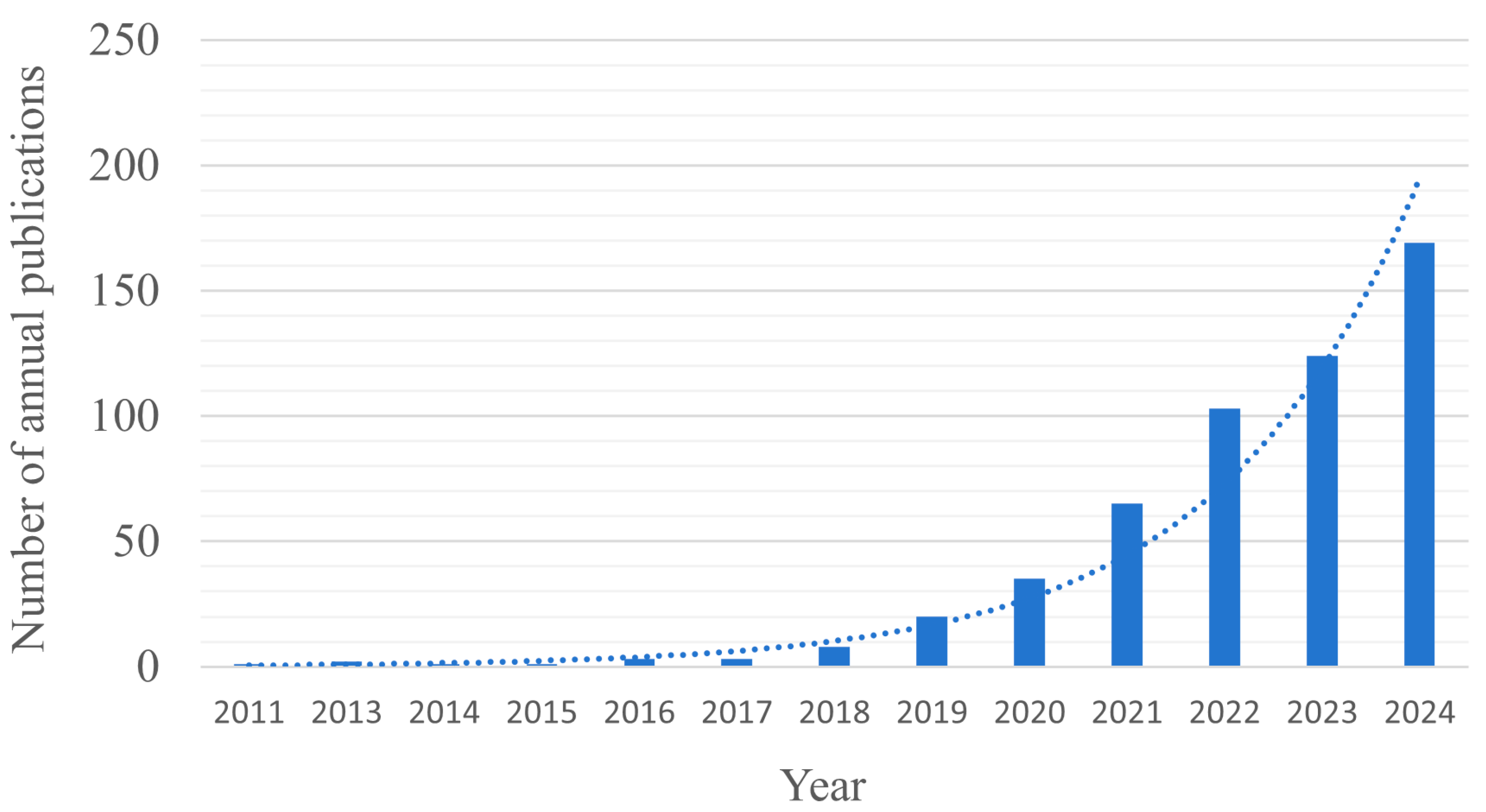
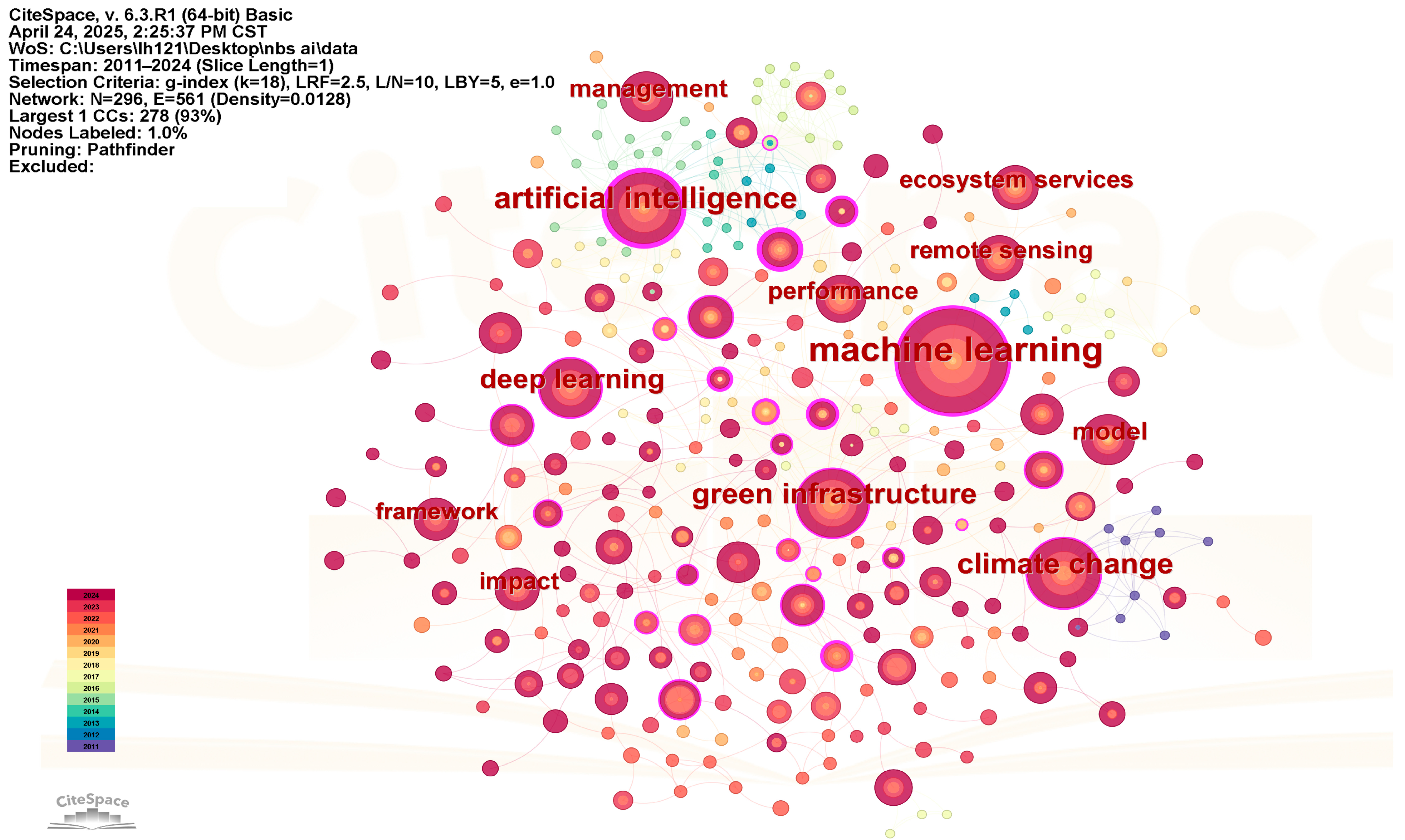
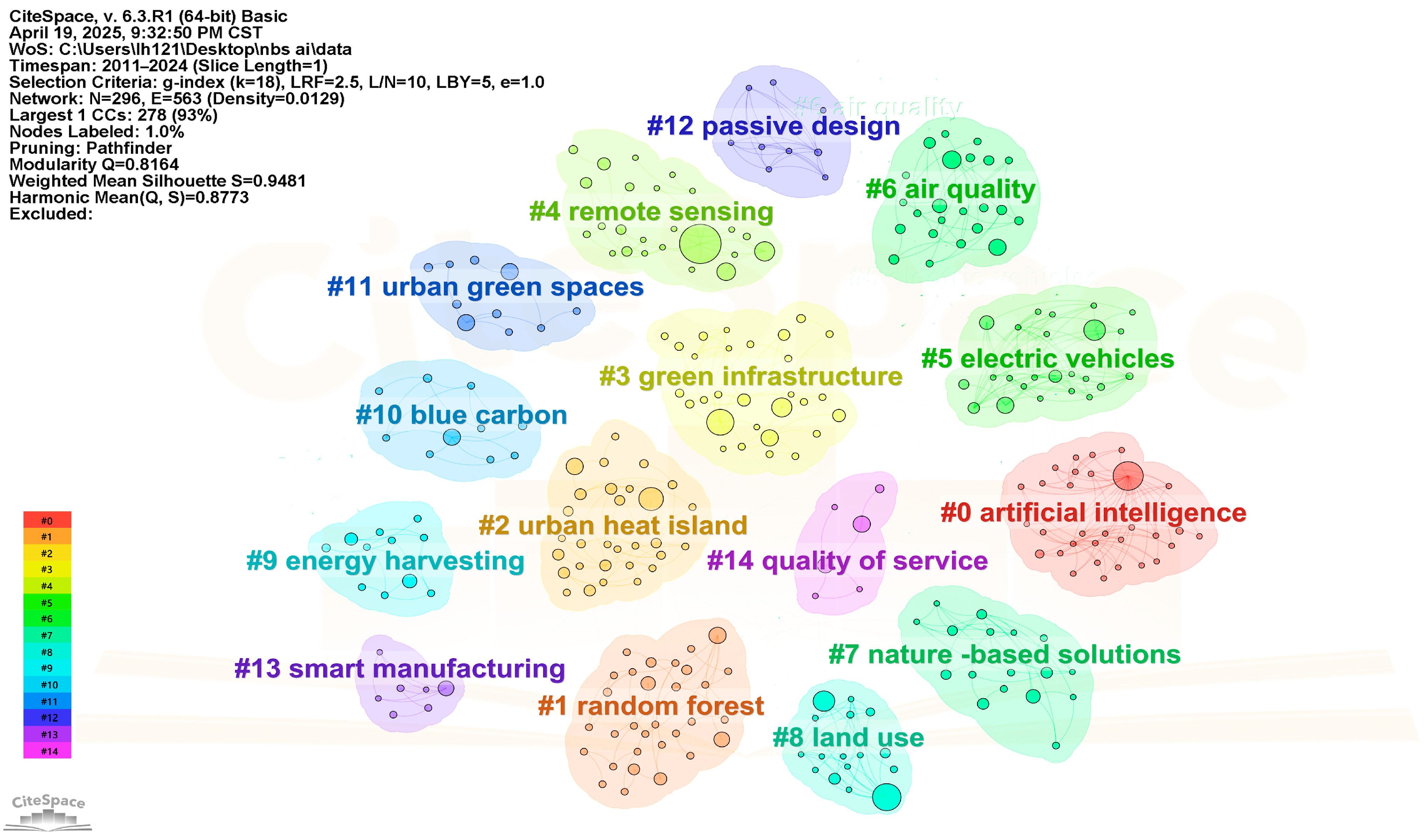
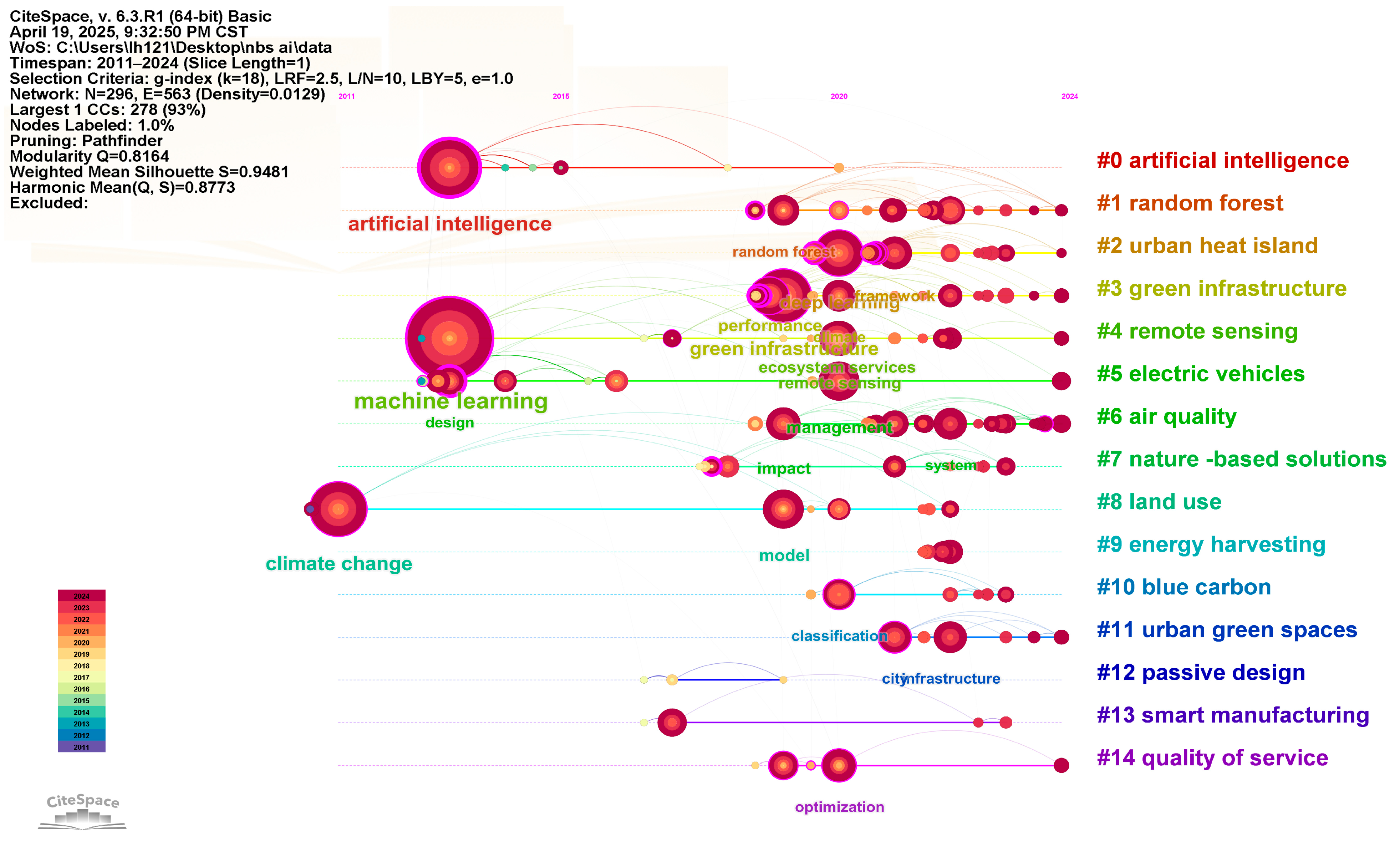
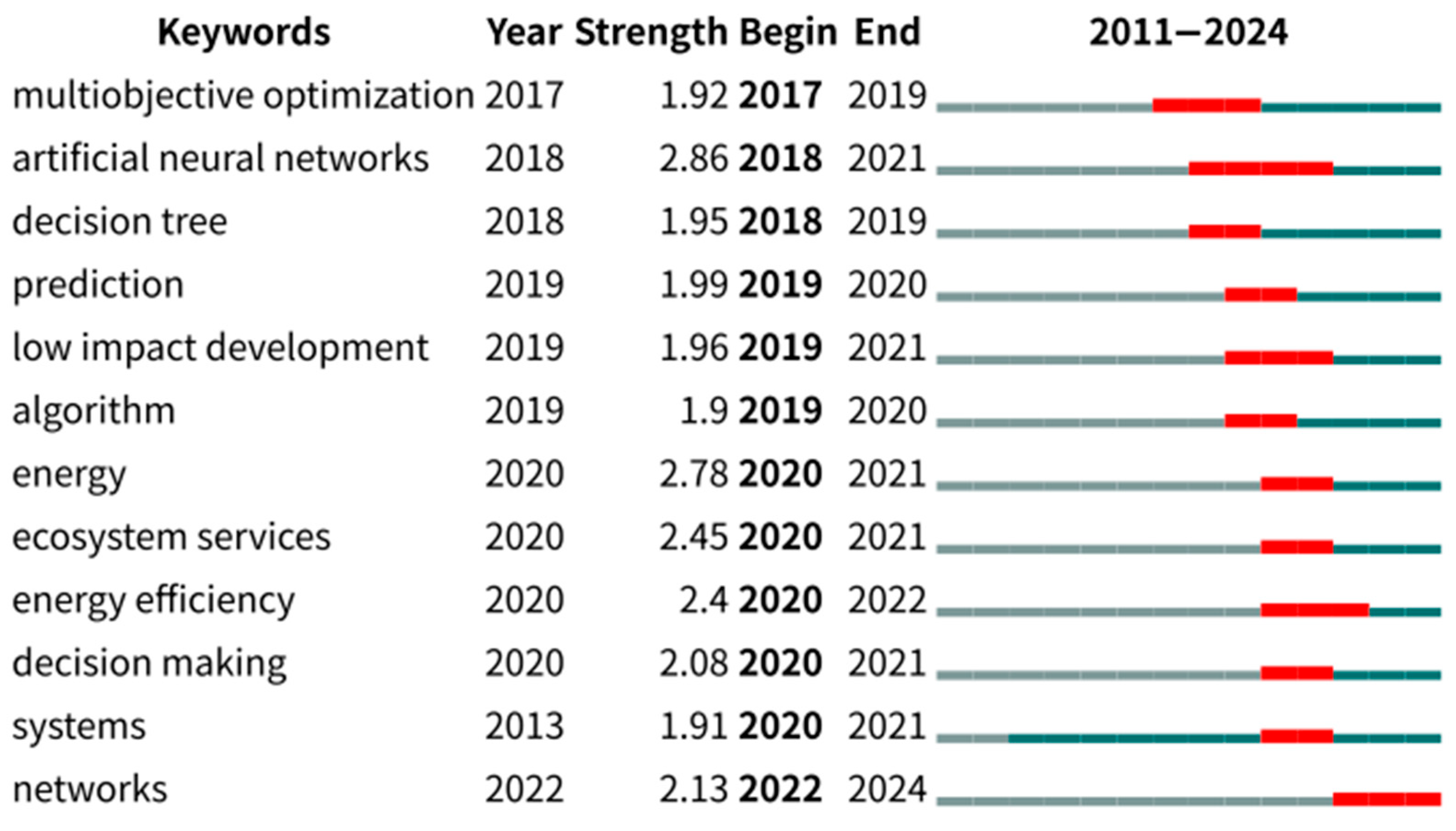
| Step | Key Parameters |
|---|---|
| Data preparation | Web of science core collection, three-stage screening |
| Bibliometric modeling | CiteSpace 6.3.R1, thesaurus, pathfinder algorithm, 1-year time slicing |
| Topic extraction | LLR algorithm, Q-value/S-value, top 5 keywords |
| LLM topic labeling(gpt-4.0) | GPT-4.0, fixed prompt, low-randomness settings, multiple runs |
| Expert validation | Dual-expert review, consensus resolution, minimal editing |
| ID | Keywords (Sorted by Keyword Count) | Count | Centrality | Year of First Appearance | ID | Keywords (Sorted by Centrality) | Count | Centrality | Year of First Appearance |
|---|---|---|---|---|---|---|---|---|---|
| 1 | machine learning | 134 | 0.31 | 2013 | 1 | artificial intelligence | 72 | 0.44 | 2013 |
| 2 | artificial intelligence | 72 | 0.44 | 2013 | 2 | design | 21 | 0.41 | 2013 |
| 3 | climate change | 61 | 0.16 | 2011 | 3 | machine learning | 134 | 0.31 | 2013 |
| 4 | green infrastructure | 57 | 0.13 | 2019 | 4 | artificial neural network | 6 | 0.27 | 2018 |
| 5 | deep learning | 43 | 0.13 | 2020 | 5 | air pollution | 8 | 0.27 | 2020 |
| 6 | management | 32 | 0.01 | 2020 | 6 | technology | 8 | 0.27 | 2019 |
| 7 | model | 32 | 0.07 | 2019 | 7 | algorithm | 10 | 0.26 | 2019 |
| 8 | performance | 29 | 0.09 | 2019 | 8 | artificial neural networks | 6 | 0.21 | 2018 |
| 9 | remote sensing | 28 | 0.05 | 2020 | 9 | emissions | 9 | 0.2 | 2021 |
| 10 | ecosystem services | 26 | 0 | 2020 | 10 | algorithms | 4 | 0.19 | 2019 |
| Cluster | Publications (Size) | ChatGPT Generate Topics | Top Terms (LLR) |
|---|---|---|---|
| 0 | 31 | Intelligent Green Computing and Natural System Optimization | Artificial intelligence (36.59, 1.0 × 10−4); computer applications (10.47, 0.005); computer operations (10.47, 0.005); (activities and operations) (10.47, 0.005); carbon footprint (9.3, 0.005) |
| 1 | 31 | Intelligent Ecological Monitoring and Carbon Reduction Optimization | Random forest (9.24, 0.005); carbon emission (8.75, 0.005); forest restoration (8.75, 0.005); internet of things (iot) (8.75, 0.005); internet of things (5.52, 0.05) |
| 2 | 30 | Intelligent Climate Analysis and Urban Heat Island Mitigation | Artificial intelligence (8.52, 0.005); urban heat island (7.85, 0.01); urban heat mitigation (5.42, 0.05); air temperature (5.42, 0.05); cluster analysis (4.5, 0.05) |
| 3 | 29 | Ecological Infrastructure and Carbon Stock Optimization | Green infrastructure (18.23, 1.0 × 104); blue infrastructure (9.4, 0.005); ecosystem-based adaptation (9.11, 0.005); carbon stock (9.11, 0.005); ecological engineering (9.11, 0.005) |
| 4 | 24 | Intelligent Remote Sensing and Ecosystem Services Assessment | Remote sensing (30.41, 1.0 × 10−4); machine learning (14.32, 0.001); artificial intelligence (13.36, 0.001); ecosystem services (11.18, 0.001); hyperspectral (7.33, 0.01) |
| 5 | 24 | Intelligent Low-Carbon Transportation and Energy Systems | Electric vehicles (7.56, 0.01); fast charging stations (5.62, 0.05); susceptibility assessment (5.62, 0.05); hydrogen production (5.62, 0.05); microgrids (5.62, 0.05) |
| 6 | 23 | Intelligent Urban Design and Environmental Quality Enhancement | Air quality (7.94, 0.005); natural hazards (6.86, 0.01); qgis and built-up (5.26, 0.05); urban designs (5.26, 0.05); outdoor recreation (5.26, 0.05) |
| 7 | 17 | Intelligent Ecological Restoration and Nature-Based Solutions Application | Nature-based solutions (11.25, 0.001); artificial neural network (8.95, 0.005); nature-based solutions (8.04, 0.005); ecosystem restoration (5.95, 0.05); leaf lettuce (5.62, 0.05) |
| 8 | 16 | Intelligent Land Management and Hydrological Connectivity | Land use (9.46, 0.005); artificial intelligence (ai) (8.1, 0.005); remote sensing (6.46, 0.05); artificially intelligence commons (4.57, 0.05); hydrological connectivity (4.57, 0.05) |
| 9 | 11 | Intelligent Green Technologies and Transportation System Optimization | Energy harvesting (13.69, 0.001); computer vision (9.94, 0.005); green products (9.94, 0.005); connected and autonomous vehicles (cavs) (6.83, 0.01); human activity categorization (6.83, 0.01) |
| 10 | 10 | Intelligent Remote Sensing and Blue Carbon Ecosystem Monitoring | Blue carbon (16.86, 1.0 × 10−4); earth observation (14.69, 0.001); sentinel 2 (7.61, 0.01); community (7.06, 0.01); unmanned aerial vehicles (7.06, 0.01) |
| 11 | 10 | Intelligent Urban Green Space Analysis and Planning Trends | Urban green spaces (13.45, 0.001); bibliometric analysis (7.93, 0.005); urban planning (7.71, 0.01); science mapping (6.65, 0.01); semantic segmentation (6.65, 0.01) |
| 12 | 9 | Intelligent Green Building and Low-Energy Design | Passive design (12.13, 0.001); energy demand (12.13, 0.001); green building (9.36, 0.005); surrogate model (7.14, 0.01); machine learning (1.2, 0.5) |
| 13 | 7 | Intelligent Manufacturing Systems and Process Optimization | Smart manufacturing (16.04, 1.0 × 10−4); process industry (7.99, 0.005); transmission (7.99, 0.005); production (7.99, 0.005); cyber-physical-social systems(cpsss) (7.99, 0.005) |
| 14 | 6 | Intelligent Infrastructure Monitoring and Low-Carbon Management | Quality of service (8.67, 0.005); shm implementation strategy (7.03, 0.01); aquifer brine (7.03, 0.01); construction project management (7.03, 0.01); carbon dioxide (7.03, 0.01) |
Disclaimer/Publisher’s Note: The statements, opinions and data contained in all publications are solely those of the individual author(s) and contributor(s) and not of MDPI and/or the editor(s). MDPI and/or the editor(s) disclaim responsibility for any injury to people or property resulting from any ideas, methods, instructions or products referred to in the content. |
© 2025 by the authors. Licensee MDPI, Basel, Switzerland. This article is an open access article distributed under the terms and conditions of the Creative Commons Attribution (CC BY) license (https://creativecommons.org/licenses/by/4.0/).
Share and Cite
Wang, M.; Liu, H.; Zhang, M.; Adnan, R.M. Advancing Nature-Based Solutions with Artificial Intelligence: A Bibliometric and Semantic Analysis Using ChatGPT. Atmosphere 2025, 16, 1102. https://doi.org/10.3390/atmos16091102
Wang M, Liu H, Zhang M, Adnan RM. Advancing Nature-Based Solutions with Artificial Intelligence: A Bibliometric and Semantic Analysis Using ChatGPT. Atmosphere. 2025; 16(9):1102. https://doi.org/10.3390/atmos16091102
Chicago/Turabian StyleWang, Mo, Hui Liu, Menghan Zhang, and Rana Muhammad Adnan. 2025. "Advancing Nature-Based Solutions with Artificial Intelligence: A Bibliometric and Semantic Analysis Using ChatGPT" Atmosphere 16, no. 9: 1102. https://doi.org/10.3390/atmos16091102
APA StyleWang, M., Liu, H., Zhang, M., & Adnan, R. M. (2025). Advancing Nature-Based Solutions with Artificial Intelligence: A Bibliometric and Semantic Analysis Using ChatGPT. Atmosphere, 16(9), 1102. https://doi.org/10.3390/atmos16091102








